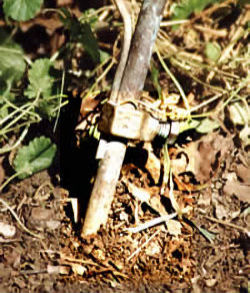Control Hazards of Shocking Currents
Ground Circuits and Equipment
When an electrical system is not grounded properly, the parts of an electrical wiring system that a person normally touches may be energized, or live, relative to ground.

Parts like switch plates, wiring boxes, conduit, cabinets, and lights need to be at 0 volts relative to ground. If the system is grounded improperly, these parts may be energized.
"Grounding" is connecting an electrical system to the earth with a wire. Excess or stray current travels through the "ground wire" to grounding rods buried in the earth. Rods used for grounding should be:
- made of 5/8th inch copper or steel
- at least 2 feet from a foundation wall
- located at least 6 feet apart
- driven into the ground to an 8 foot depth
Sometimes an electrical system receives a higher voltage than it is designed to handle, or a defect occurs in a device that allows exposed metal parts to become energized. Grounding will help protect the person working on a circuit, and others using tools or operating equipment connected to the circuit.
Leakage current. Leakage current occurs when an electrical current escapes from its intended path. Leakages are sometimes low-current faults that can occur in all electrical equipment because of dirt, wear, damage, or moisture. A good grounding system should be able to carry off this leakage current.
Ground faults. A ground fault occurs when current passes through the housing of an electrical device to ground. Ground faults are usually caused by misuse of a tool or damage to its insulation that allows a bare conductor to touch metal parts or the tool housing.
Equipment needs to be grounded under any of these circumstances:
- The equipment is within 8 feet vertically and 5 feet horizontally of the floor or walking surface.
- The equipment is within 8 feet vertically and 5 feet horizontally of grounded metal objects you could touch.
- The equipment is located in a wet or damp area and is not isolated.
- The equipment is connected to a power supply by cord and plug and is not double-insulated.
Knowledge Check Choose the best answer for the question.
7-8. Parts like switch plates, wiring boxes, conduit, cabinets, and lights need to be at _____ relative to ground.
You forgot to answer the question!
